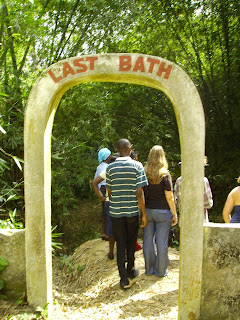This past weekend me and Des decided to head northeast to visit the Volta Region which really is my favorite region in all of Ghana. We caught a tro-tro from Madina to Hohoe on Friday morning and the trip should have gotten us there in 4 hours so we would get there by 2. Of course, there has never been a time where we have gotten to any of our destinations smoothly so why should it start now? With that being said, when we reached the bridge that crosses the Volta river to get us on the other side, it was closed so we had to wait in traffic for 2 hours before getting across. After 6 hours filled with catching a cockroach on my leg, sitting on the seat directly above the engine so it was super uncomfortable and traffic, we finally got to Hohoe. It was too late to try to do anything that day so we got our hotel and went out for dinner. We just happened to get there when there was a city wide power outage so after dinner we had to hang outside of our room because unless the fans are on, it’s too hot to be inside. Eventually the power came back on so all was good.
The plan for the weekend was climb Mount Afadjato, the tallest mountain in Ghana, see the Tagbo waterfalls on the backside of the mountain and visit the nearby kente village at Tafi Abuibe. Saturday we got up early, got a power breakfast in, bought about 6 bottles of water and caught a taxi to the village of Liati Wote where the mountain was located. It takes about an hour on an unpaved road to get there from Hohoe so we got there by 9:30 but once we did the mountain didn’t look as ferocious as we thought it would. We signed in at the visitor center and they gave us our guide but they said it would only take 45 minutes to an hour to get to the top. We were slightly disappointed because we were so pumped for the challenge. Compared to our last hike in the Volta Region to the Wli Waterfalls where we hiked for 6 hours in the pouring rain and in sandals, we were really prepared this time. We had the proper attire on, sweatrags, bandannas, sunblock and loads of water and we were just worried it wouldn’t be put to good use. Once we started hiking the first 10 minutes were ok under the sun then the trail turned vertical real quick. I regretted thinking this wouldn’t be as hard as we thought. The entire trail was like a steep staircase and we literally stopped every 5 minutes to catch our breath and the sun wasn’t helping even though it was only 10. I thought I was gonna pass out or throw up a few times and I really wanted to quit halfway through but I didn’t come all this way to quit. At the final stretch, we caught a break and a cloud covered the sun so we finished hard to get to the top before it went away. The minute we got to the top the cloud went away so I figured that we were close enough that God heard my thoughts ha. It was so beautiful at the top and we could even see Togo on the other side of the mountain. We chilled up there and caught our breath before heading down again. It took us another hour to get down then from there we hiked/walked to the backside where the falls were at. After 45 minutes of that we got to the waterfalls and even though it wasn’t as big as the Wli waterfalls, it was still pretty gorgeous. It was secluded and covered in different types of butterflies. I even actually got to hold one when I put my hand down and it climbed on top and stayed for about a minute. We hung out for a bit before walking back into the village from where we caught a tro-tro back to Hohoe. We still had some time left in the day so we figured we might as well try to get to the kente village that day. It was a failed attempt considering our taxi driver couldn’t figure out where it was and kept getting false directions and we ended up at an even smaller kente village where they were done for the day and weren’t making it anymore. By that time it was getting late to keep trying so we had to walk to the nearby junction to catch another tro-tro back.
Most of the adventure was on Saturday because we left early Sunday morning and got back to campus by noon. Luckily, that was a much smoother ride but then again it’s almost always smooth getting back, just not getting there.

























































